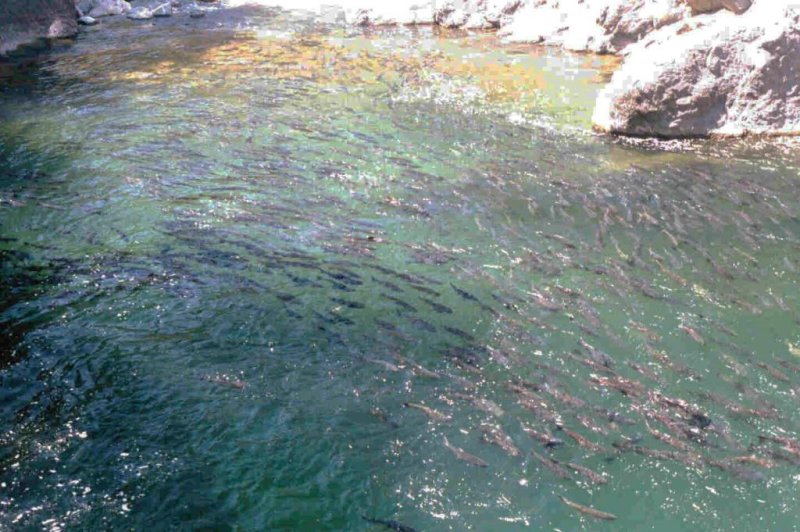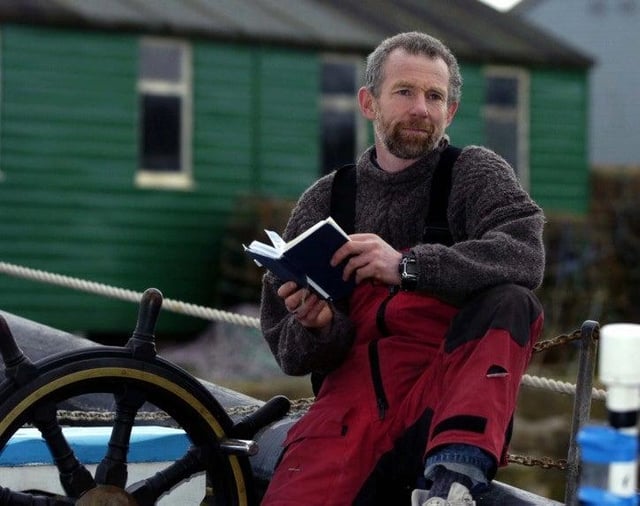high-tech fish farming, tourism

Genghai No 1, China's first ecological marine ranch platform, is anchored off the coast of Yantai, Shandong Province, on Thursday. Photo by Stephen Shaver/UPI | License Photo
Oct. 29 (UPI) -- Chinese industry and tourism officials are touting a recently opened "intelligent ecological marine ranch" as a potential game-changer for the country's depleted fishing waters.
Genghai No.1, a marine farm owned by the Shandong Ocean Harvest Corp., opened in July off the coast of Yantai in northeastern Shandong Province as a model of how modern, high-tech fishing techniques can be combined with tourism to revitalize and preserve the industry.
Marine ecosystems in most coastal areas of Shandong have been disrupted over the past 50 years by overfishing and the deterioration of coastal environments, endangering the fish resources.
But local and national leaders are now leading a push to transform the area's fishing economy with marine ranches. With nearly 1,000 square miles of ocean areas suitable for the construction of high-quality ocean ranches, Yantai has emerged as hotbed in the emerging technology, Chinese officials say.
RELATED Overfishing erased sharks from many of the world's reefs, researchers say
Marine ranching, first developed in the 1970s, is a type of aquaculture involving the cultivation of marine organisms for food and other products in an enclosed section of ocean.
The process involves placing artificial reefs on the seabed, releasing juvenile fish, and encouraging the growth of kelp forests. The ranches have also emerged as popular destinations for tourism and leisure fishing in China.
Backers have hailed Genghai No.1 as China's first large-scale "intelligent" ocean ranching platform, making use of artificial intelligence, clean energy, 5G communications, big data and underwater patrol robots.
With a total diameter of 260 feet and a water volume equivalent to 14 swimming pools, the ranch is composed of three identical and rotating sub-cages and is equipped with an automatic system for environmental monitoring and ship collision prevention.
It is expected to produce 330,000 pounds of fish and receive 50,000 tourists annually.

Genghai No 1, China's first ecological marine ranch platform, is anchored off the coast of Yantai, Shandong Province, on Thursday. Photo by Stephen Shaver/UPI | License Photo
Oct. 29 (UPI) -- Chinese industry and tourism officials are touting a recently opened "intelligent ecological marine ranch" as a potential game-changer for the country's depleted fishing waters.
Genghai No.1, a marine farm owned by the Shandong Ocean Harvest Corp., opened in July off the coast of Yantai in northeastern Shandong Province as a model of how modern, high-tech fishing techniques can be combined with tourism to revitalize and preserve the industry.
Marine ecosystems in most coastal areas of Shandong have been disrupted over the past 50 years by overfishing and the deterioration of coastal environments, endangering the fish resources.
But local and national leaders are now leading a push to transform the area's fishing economy with marine ranches. With nearly 1,000 square miles of ocean areas suitable for the construction of high-quality ocean ranches, Yantai has emerged as hotbed in the emerging technology, Chinese officials say.
RELATED Overfishing erased sharks from many of the world's reefs, researchers say
Marine ranching, first developed in the 1970s, is a type of aquaculture involving the cultivation of marine organisms for food and other products in an enclosed section of ocean.
The process involves placing artificial reefs on the seabed, releasing juvenile fish, and encouraging the growth of kelp forests. The ranches have also emerged as popular destinations for tourism and leisure fishing in China.
Backers have hailed Genghai No.1 as China's first large-scale "intelligent" ocean ranching platform, making use of artificial intelligence, clean energy, 5G communications, big data and underwater patrol robots.
With a total diameter of 260 feet and a water volume equivalent to 14 swimming pools, the ranch is composed of three identical and rotating sub-cages and is equipped with an automatic system for environmental monitoring and ship collision prevention.
It is expected to produce 330,000 pounds of fish and receive 50,000 tourists annually.




















 © JAVIER TORRES View of a luxury cars store at Lo Barnechea commune in Santiago. Nearly 80 percent of Chileans voted to rip up the constitution established under the 1973-1990 dictatorship of Augusto Pinochet, seen as the root of the country's jarring inequalities
© JAVIER TORRES View of a luxury cars store at Lo Barnechea commune in Santiago. Nearly 80 percent of Chileans voted to rip up the constitution established under the 1973-1990 dictatorship of Augusto Pinochet, seen as the root of the country's jarring inequalities
